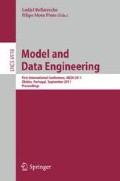Abstract
Economical crisis in recent years leads the banks to pay more attention to credit risk assessment. Financial institutes have used various kinds of decision support systems, to reduce their credit risk. Credit scoring is one of the most important systems that have been used by the banks and financial institutes. In this paper, an application of locally linear model tree (LOLIMOT) algorithm was experimented to improve the predictive accuracy of credit scoring. Using the Australian credit data from UCI machine learning database repository, the algorithm was found an increase in predictive accuracy in comparison with some other well-known methods in the credit scoring area. The experiments also indicate that LOLIMOT get the best result in terms of average accuracy and type I and II error.
Access this chapter
Tax calculation will be finalised at checkout
Purchases are for personal use only
Preview
Unable to display preview. Download preview PDF.
References
Chen, F., Li, F.: Combination of Feature Selection Approaches with SVM in Credit Scoring. Expert Systems with Applications 37, 4902–4909 (2010)
Wang, G., Hao, J., Ma, J., Jiang, H.: A Comparative Assessment of Ensemble Learning for Credit Scoring. Expert System with Applications 38, 223–230 (2011)
Zhang, D., Zhou, X., et al.: Vertical Bagging Decision Trees Model for Credit Scoring. Expert System with Applications 37, 7838–7843 (2010)
Chen, W., Ma, C., Ma, L.: Mining the customer credit using hybrid support vector machine technique. Expert Systems with Applications 36, 7611–7616 (2009)
Hsieh, N.C.: Hybrid Mining Approach in the Design of Credit Scoring Models. Expert System with Applications 28, 655–665 (2005)
Tsai, C.F., Wu, J.W.: Using Neural Network Ensembles for Bankruptcy Prediction and Credit Scoring. Expert Systems with Applications 34, 2639–2649 (2008)
TunLi, S., Shiue, W., Huang, M.H.: The Evaluation of Consumer Loans Using Support Vector Machines. Expert System with Application 30, 772–782 (2006)
Leea, T., Chiub, C.C., Chouc, Y.C., Lud, C.J.: Mining the customer credit using classification and regression tree and multivariate adaptive regression splines. Expert System with Applications 50, 1113–1130 (2006)
On, C.S., Huang, J.J., Tzeng, G.H.: Building credit scoring model using genetic programming. Expert System with Application 29, 41–47 (2005)
Huang, C.L., Chen, M.C., Wang, C.J.: Credit Scoring with Data Mining Approach Based on Support Vector Machine. Expert System with Application 37, 847–856 (2007)
XiuXuan, X., Chunguang, Z., Zhe, W.: Credit Scoring Algorithm Based on Link Analysis Ranking with Support Vector Machine. Expert System with Application 36, 2625–2632 (2009)
Ghorbani, A., Taghiyareh, F., Lucas, C.: The Application of the Locally Linear Model Tree on Customer Churn Prediction. In: SoCPaR, pp. 472–477 (2009)
Thomas, L.C.: A Survey of Credit and Behavioral Scoring: Forecasting Financial Risk of Lending to Consumers. International Journal of Forecasting 16, 149–172 (2000)
Nanni, L., Lumini, A.: An Experimental Comparison of Ensemble of Classifiers for Bankruptcy Prediction and Credit scoring. Expert System with Applications 36, 3028–3033 (2009)
Gholipour, A., et al.: Solar activity forecast: Spectral analysis and neurofuzzy prediction. Journal of Atmospheric and Solar-Terrestrial Physics 67(6), 595–603 (2005)
Nelles, O.: Nonlinear system identification: from classical approaches to neural networks and fuzzy models. Springer, Heidelberg (2001)
Sharifie, J., Lucas, C., Araabi, B.N.: Locally linear neurofuzzymodeling and prediction of geomagnetic disturbances based on solar wind conditions. Space Weather (April 2006)
Pedram, A., Jamali, M., Pedram, T., et al.: Local Linear Model Tree (LOLIMOT) Reconfigurable Parallel Hardware. International Journal of Applied Science, Engineering and Technology 1, 1 (2005)
Author information
Authors and Affiliations
Editor information
Editors and Affiliations
Rights and permissions
Copyright information
© 2011 Springer-Verlag Berlin Heidelberg
About this paper
Cite this paper
Siami, M., Gholamian, M.R., Basiri, J., Fathian, M. (2011). An Application of Locally Linear Model Tree Algorithm for Predictive Accuracy of Credit Scoring. In: Bellatreche, L., Mota Pinto, F. (eds) Model and Data Engineering. MEDI 2011. Lecture Notes in Computer Science, vol 6918. Springer, Berlin, Heidelberg. https://doi.org/10.1007/978-3-642-24443-8_15
Download citation
DOI: https://doi.org/10.1007/978-3-642-24443-8_15
Publisher Name: Springer, Berlin, Heidelberg
Print ISBN: 978-3-642-24442-1
Online ISBN: 978-3-642-24443-8
eBook Packages: Computer ScienceComputer Science (R0)

